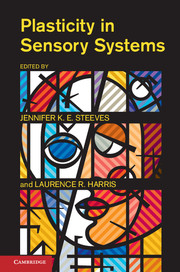Book contents
- Frontmatter
- Contents
- List of Contributors
- 1 Plasticity in Sensory Systems
- I VISUAL AND VISUOMOTOR PLASTICITY
- 2 The Distributed Nature of Visual Object Learning
- 3 Motor Adaptation and Proprioceptive Recalibration
- 4 Deficits and Adaptation of Eye-Hand Coordination During Visually Guided Reaching Movements in People with Amblyopia
- II PLASTICITY IN CHILDHOOD
- III PLASTICITY IN ADULTHOOD AND VISION REHABILITATION
- Author Index
- Subject Index
- References
4 - Deficits and Adaptation of Eye-Hand Coordination During Visually Guided Reaching Movements in People with Amblyopia
from I - VISUAL AND VISUOMOTOR PLASTICITY
Published online by Cambridge University Press: 05 January 2013
- Frontmatter
- Contents
- List of Contributors
- 1 Plasticity in Sensory Systems
- I VISUAL AND VISUOMOTOR PLASTICITY
- 2 The Distributed Nature of Visual Object Learning
- 3 Motor Adaptation and Proprioceptive Recalibration
- 4 Deficits and Adaptation of Eye-Hand Coordination During Visually Guided Reaching Movements in People with Amblyopia
- II PLASTICITY IN CHILDHOOD
- III PLASTICITY IN ADULTHOOD AND VISION REHABILITATION
- Author Index
- Subject Index
- References
Summary
Introduction
Amblyopia is a visual impairment of one eye caused by inadequate use during early childhood and cannot be corrected by optical means (American Academy of Ophthalmology, 2007). Clinically, it is usually defined as a visual acuity of 20/30 or worse without any apparent structural abnormality in the affected eye. Amblyopia is a significant public health issue because it is the number one cause of monocular visual loss worldwide, affecting 3 to 5 percent of the population in the Western world (Attebo et al., 1998; Hillis, 1986). Because of its prevalence, the financial burden of amblyopia is enormous. A major U.S. study estimated that untreated amblyopia causes a yearly loss of US$7.4 billion in earning power and a corresponding decrease in the gross domestic product. An estimated US$341 million is spent each year to prevent and treat amblyopia (Membreno et al., 2002). Unfortunately, approximately 50 percent of patients do not respond to therapies (Holmes, Beck, et al., 2003; Holmes, Kraker, et al., 2003; The Pediatric Eye Disease Investigator Group [PEDIG], 2003; Repka et al., 2004, 2008; Scheiman et al., 2005). The personal cost of amblyopia is also substantial. People with amblyopia (including those treated successfully and those whose treatment failed) often have limited career choices and reduced quality of life such as reduced social contact, distance and depth estimation deficits, visual disorientation, and fear of losing vision in the better eye (van de Graaf et al., 2004).
- Type
- Chapter
- Information
- Plasticity in Sensory Systems , pp. 49 - 72Publisher: Cambridge University PressPrint publication year: 2012



